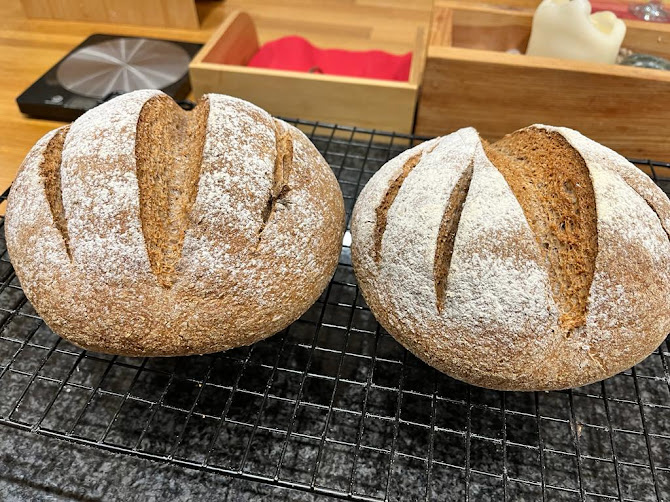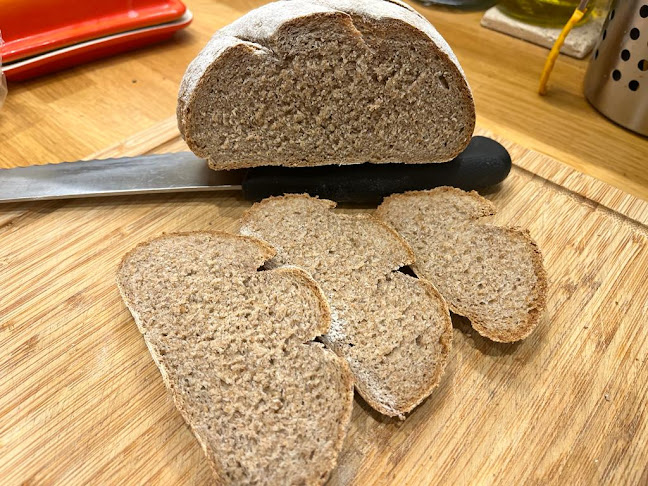Maslin Bread
During Medieval times, people with wealth ate Manchet, a bread made from more refined wheat. In fact, the richer you were, the more refined the wheat. Royalty ate Fine Manchet...not quite white flour, but definitely getting there.
You'll find a step-by-step guide to making Manchet, here:
https://breadclub20.blogspot.com/2022/09/manchet.html
Meanwhile, down at the other end of the social ladder..and, really, you couldn't get much lower, the peasants and the lower orders ate Maslin, a bread originally made using barley and pea flours and a fair bit of millstone grit. Not necessary for roughage, but probably accounted for all manner of dental problems as people moved into adulthood. Add to that, chaff, straw and the sweepings-up from the bakehouse floor, and you had a bread fit for only the very poor.
By the time we reach Tudor times, the 'best' Maslin was made from a blended flour of wheat and rye.
As time went on, farmers realised that sowing wheat on its own left you at the vagaries of nature and weather and, should the crop fail, then you had nothing to fall back on. It became common to sow wheat and rye together as something of an insurance policy.
In Wales, where I'm sitting at the moment, it's often called 'Mixed Bread' or Bara Cymysg, due to the blending of flours necessary to produce an edible bread at the lowest possible cost.
However, fear not. Our Maslin today has been brought up to the 21st century, using the quality of products that we would expect. However, the same principle of blended wholewheat flour is carried forth.
INGREDIENTS
This might be bread for the poor, but I'm bringing it right up to date and deliberately using the best of everything.
575 gms wholemeal flour (I'm using 100% Canadian Wholemeal flour from Shipton Mill)
125 gms rye flour (I'm using an Organic Rye from Doves Farm)
425 gms tepid water (preferably filtered)
1 tablespoon olive or vegetable oil (I'm using olive oil)
1½ teaspoon crushed sea salt (I'm using sea salt from Ynys Môn, the Isle of Anglesey, North Wales)
1 teaspoon honey (I'm using Mêl...Welsh honey)
1 teaspoon of dried yeast
METHOD
1. Mix the dried yeast with the honey and 100 gms of tepid water. Stir, cover and leave to activate. After about 10 minutes, it should be foaming.
2. Mix the wholemeal and rye flours and warm them slightly.
3. Add the yeast mixture and then the remainder of the water and the salt. Combine thoroughly.
4. Knead to a soft dough and then place in a lightly-oiled bowl, cover and allow to double.
 |
| After kneading |
 |
| After first proof |
5. Knock back, divide into two and give each portion it a very light knead and then shape into tight boules.
6. Place on a floured baking tray, cover and allow to proof until it has roughly doubled in size. This should take about 40 minutes. However, watch the dough, not the clock.
.jpeg) |
| Before second proof |
 |
| After second proof |
7. Preheat the oven to 230⁰C.
8. Bake for 15 minutes at 230⁰C and then for a further 35 minutes at 200⁰C or until the loaf is golden and hollow when tapped on the underneath.
9. Cool on a rack.
Happy baking...





.jpeg)
.jpeg)



Comments
Post a Comment